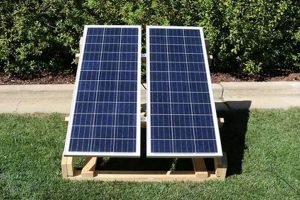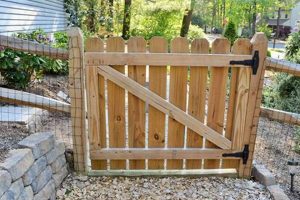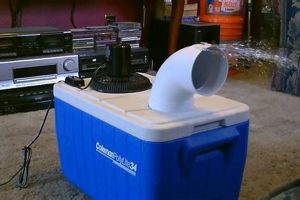The concept involves the construction of a lawn or garden watering system by an individual, utilizing readily available materials and tools, instead of purchasing a pre-assembled commercial unit. For instance, a homeowner might construct a water dispersal mechanism using PVC pipes, fittings, and sprinkler heads sourced from a hardware store.
This approach to irrigation offers several advantages, including cost savings and customization. The ability to tailor the system to specific landscape requirements, coupled with the potential for repurposing materials, contributes to resource efficiency. Historically, similar methods of water distribution have been employed in agriculture and landscaping to manage water usage and promote plant health.
The following sections will delve into the various design considerations, construction techniques, and potential challenges associated with fabricating such a system, providing a practical guide for those seeking to implement this strategy.
DIY Sprinkler System Optimization
The following recommendations are intended to maximize the effectiveness and longevity of a self-constructed irrigation system.
Tip 1: Pressure Regulation is Paramount. Inadequate or excessive water pressure can compromise system performance. Install a pressure regulator to maintain optimal output from sprinkler heads and prevent damage to components.
Tip 2: Employ Durable Materials. Selection of high-quality PVC pipe and fittings is crucial. Schedule 40 PVC is generally recommended for its resistance to pressure and environmental degradation.
Tip 3: Implement Proper Drainage. Stagnant water can lead to algae growth and system malfunctions. Incorporate drainage valves at low points in the system to facilitate seasonal winterization and prevent freezing.
Tip 4: Optimize Sprinkler Head Placement. Strategically position sprinkler heads to achieve uniform water coverage and minimize overspray onto non-vegetated surfaces. Consider wind patterns and plant water requirements during placement.
Tip 5: Utilize a Timer for Automated Operation. A programmable timer allows for consistent and efficient watering schedules, reducing water waste and promoting plant health. Ensure the timer is compatible with the system’s voltage and flow rate.
Tip 6: Regularly Inspect for Leaks. Periodic inspection of all connections and sprinkler heads is essential to identify and repair leaks promptly. Small leaks can quickly escalate into significant water loss.
Tip 7: Winterize the System Appropriately. In regions subject to freezing temperatures, complete winterization is mandatory to prevent pipe bursting. This involves draining all water from the system and, in some cases, blowing out the lines with compressed air.
Adhering to these guidelines will contribute to a reliable and efficient irrigation solution, minimizing water consumption and promoting healthy plant growth.
The subsequent section will address troubleshooting common issues encountered with these systems.
1. Component Selection
Component selection directly influences the functionality, longevity, and cost-effectiveness of any self-engineered watering system. The choice of materials dictates resistance to environmental factors such as UV radiation and temperature fluctuations, impacting the overall lifespan. For example, opting for Schedule 40 PVC over thinner-walled alternatives increases durability, preventing premature cracking and leaks under pressure. Inadequate component choice is a frequent cause of system failure.
Consideration of sprinkler head types is also critical. Impact rotors provide broader coverage but require higher pressure, while spray nozzles offer finer control but shorter range. Matching the sprinkler head to the available water pressure and plant water requirements is essential for efficient water distribution. The implementation of incorrect fittings or connectors can lead to pressure drops and uneven watering patterns. Use case dictates component requirements.
Appropriate component selection mitigates maintenance demands, reduces water wastage, and enhances the overall effectiveness of the self-engineered irrigation system. Proper planning, in conjunction with informed material choices, enables the creation of a custom-tailored watering solution that aligns with specific landscape needs. The direct correlation between part quality and system performance warrants careful consideration of all components during the design and construction process.
2. Pressure Regulation
In the context of self-assembled irrigation systems, maintaining appropriate water pressure is paramount for operational effectiveness and longevity. Inadequate or excessive pressure directly influences sprinkler head performance, potentially resulting in either insufficient water dispersal or component damage. A homeowner, for instance, might experience uneven watering patterns across a lawn if the water pressure exceeds the optimal operating range of the installed spray nozzles. This phenomenon not only reduces irrigation efficiency but can also lead to accelerated wear and tear on system components, necessitating frequent replacements.
Implementing pressure regulation within the system can be achieved through the installation of a pressure regulator valve. These valves, commonly available at hardware stores, are designed to automatically reduce incoming water pressure to a pre-set level. This ensures consistent water flow to each sprinkler head, irrespective of fluctuations in the main water supply. A practical example includes a system connected to a municipal water supply with fluctuating pressure; a regulator maintains a constant output, mitigating potential damage and optimizing water distribution.
In summation, effective pressure regulation is an indispensable element of successful irrigation system design and construction. Without proper management of water pressure, the entire system is vulnerable to inefficiency, damage, and reduced lifespan. The integration of a pressure regulator is, therefore, a crucial step in guaranteeing the reliable and sustainable performance of the water delivery mechanism.
3. Coverage Uniformity
Coverage uniformity, defined as the consistent and equitable distribution of water across a designated area, is a pivotal consideration in the design and implementation of any self-constructed irrigation system. The effectiveness of a watering system is directly proportional to its ability to deliver water evenly, ensuring all vegetation receives adequate hydration.
- Sprinkler Head Selection and Spacing
The choice of spri
nkler heads whether oscillating, rotating, or fixed along with their strategic arrangement, dictates water distribution patterns. Overlapping coverage patterns are often necessary to compensate for variations in pressure and wind drift. Inadequate spacing results in dry spots, while excessive overlap leads to water wastage. Examples include utilizing matched precipitation rate nozzles, where each head emits water at the same rate, regardless of pattern, and adjusting sprinkler head spacing based on manufacturer specifications and site-specific conditions. Inconsistent output can lead to localized overwatering and underwatering, resulting in uneven plant growth and increased susceptibility to disease. - System Pressure Maintenance
Sufficient and consistent water pressure is essential for achieving the designed spray pattern. Fluctuations in pressure can distort patterns, leading to uneven distribution. As mentioned before, the integration of a pressure regulator mitigates pressure variations. The lack of consistent pressure causes the sprinkler head can deviate from the original designed water throwing range, which leads to some area will be underwatering.
- Nozzle Clogging and Maintenance
Debris and mineral deposits can obstruct nozzles, altering spray patterns and reducing flow rates. Regular cleaning and inspection of sprinkler heads are vital for maintaining consistent water distribution. Filtration systems may be necessary in areas with hard water or high sediment levels. Clogged nozzles directly compromise uniformity, requiring proactive maintenance to ensure consistent performance.
- Wind Drift Compensation
Wind significantly impacts spray patterns, particularly in exposed areas. Adjusting sprinkler head direction and utilizing wind-resistant nozzles can minimize the effects of wind drift, ensuring uniform coverage. Overlapping patterns are especially critical in windy environments. Failure to account for wind drift leads to uneven watering and inefficient water usage.
Therefore, meticulous planning and diligent maintenance are required to optimize coverage uniformity in a self-built watering system. Addressing these factors is a prerequisite for maximizing plant health, minimizing water waste, and ensuring the long-term effectiveness of the irrigation system.
4. Material Compatibility
In the context of self-constructed irrigation systems, material compatibility is a critical consideration that directly impacts system performance, longevity, and overall reliability. The interaction between different materials, both chemical and physical, dictates the long-term integrity of the system.
- Chemical Compatibility of Plastics
The selection of PVC, CPVC, polyethylene, and other plastic components requires careful consideration of their chemical properties. Incompatible plastics can degrade, crack, or leach chemicals into the water supply. For example, using an incorrect primer or sealant can weaken PVC joints, leading to leaks and eventual system failure. Understanding the specific chemical resistances of each material is essential. The material’s resistance should be assessed for fertilizer injection systems or systems that may experience non-potable water sources.
- Galvanic Corrosion Between Metals
If the system incorporates metal components, such as brass fittings or galvanized steel pipes, galvanic corrosion can occur when dissimilar metals are in contact with each other in the presence of an electrolyte (water). This electrochemical process accelerates the degradation of the more active metal. An example includes directly connecting a copper pipe to a galvanized steel pipe, leading to rapid corrosion of the steel. Dielectric unions or insulating sleeves should be implemented to mitigate this effect.
- Sealant and Adhesive Compatibility
The compatibility of sealants and adhesives with the piping materials is vital for creating leak-proof joints. Incorrect sealant types can cause the plastic to dissolve or become brittle, compromising the joint’s integrity. For instance, using a solvent-based sealant on certain polyethylene pipes can result in pipe failure. The appropriate sealant for each material should be selected and verified before assembly.
- UV Resistance of Exposed Components
Components exposed to direct sunlight are susceptible to UV degradation, which can lead to cracking, discoloration, and reduced structural strength. Certain plastics, such as standard PVC, are particularly vulnerable. Using UV-resistant PVC or applying a protective coating can extend the lifespan of exposed components. Neglecting UV protection leads to premature failure of above-ground piping and fittings.
Therefore, ensuring material compatibility is paramount when designing and constructing a self-made irrigation system. Failure to consider the interactions between different materials can result in premature system failure, leaks, and potential contamination of the water supply. Careful research and selection of compatible components are essential for a durable and reliable system.
5. System Layout
Effective arrangement of components is a fundamental prerequisite for optimal performance of any self-engineered irrigation system. System layout directly influences water distribution uniformity, operational efficiency, and overall system reliability. The spatial configuration of piping, sprinkler heads, and control elements must be carefully planned to meet the specific needs of the landscape being irrigated.
- Zoning for Hydrozoning
Dividing the irrigated area into distinct zones based on plant water requirements, sun exposure, and soil types allows for tailored watering schedules and efficient water usage. Example: separating a high-water-demand vegetable garden from a drought-tolerant xeriscape area. Implications include reduced water waste, healthier plant growth, and optimized resource allocation.
- Piping Configuration and Pressure Loss
The arrangement of pipes, including pipe diameter and length, influences pressure loss due to friction. Insufficient pipe diameter or excessively long runs can result in reduced water pressure at the sprinkler heads, leading to uneven coverage. Implementing a loop configuration or increasing pipe diameter can mitigate pressure loss. Implications involve ensuring adequate water pressure throughout the system, optimizing sprinkler head performance, and maintaining consistent water distribution.
- Sprinkler Head Placement and Overlap
Strategic placement of sprinkler heads, considering spray patterns and overlapping coverage, is crucial for achieving uniform water distribution. Insufficient overlap leads to dry spots, while excessive overlap results in water waste. Example: positioning sprinkler heads to achieve head-to-head coverage, where each head sprays to the adjacent head. Implications include minimizing water waste, preventing dry spots, and promoting even plant growth.
- Accessibility for Maintenance and Repairs
The system layout should facilitate easy access to components for maintenance, repairs, and winterization. Burying pipes too deep or obstructing access to valves and sprinkler heads can complicate repairs and increase maintenance costs. I
mplementing valve boxes and strategically placing unions allows for easier access. Implications involve reducing maintenance time, minimizing repair costs, and ensuring the long-term usability of the irrigation system.
Careful consideration of system layout is essential for creating a custom-tailored watering system that meets the specific needs of the landscape. Proper planning and strategic component arrangement contribute to improved irrigation efficiency, reduced water waste, and enhanced plant health. The overall effectiveness of a self-built irrigation solution hinges on a well-designed system layout.
6. Drainage Implementation
Effective drainage is a critical, yet often overlooked, component of a successful self-engineered irrigation system. The absence of adequate drainage provisions can lead to waterlogged soil, promoting root rot, fungal diseases, and ultimately, plant decline. The connection between the water dispersal mechanism and proper drainage is one of direct cause and effect; the introduced irrigation water must have a means of escape once the soil’s saturation point is reached.
Proper drainage implementation may involve several strategies, dependent on the soil type and topography of the irrigated area. In poorly draining clay soils, the installation of subsurface drainage tiles can facilitate the removal of excess water. Alternatively, surface grading to direct water away from plant root zones provides a simpler, less invasive solution for sloped landscapes. For example, a homeowner who constructs an automatic watering system without considering existing drainage patterns might find their lawn succumbing to fungal infections after periods of heavy irrigation. The cost of implementing drainage from the outset is often less than the cost of remediation of waterlogged soil or replacement of damaged vegetation.
In summation, drainage implementation is not merely an optional addendum to a self-assembled watering system, but a vital element for preserving plant health and optimizing the overall efficiency of the irrigation apparatus. Addressing drainage considerations during the design phase mitigates potential problems and ensures the long-term sustainability of the watering strategy.
7. Water Source Compatibility
The viability of a self-constructed irrigation system is intrinsically linked to the compatibility of its design with the available water source. Matching system requirements to water source characteristics ensures efficient operation and minimizes potential damage to both the system and the landscape.
- Pressure Requirements and Source Capacity
The operating pressure of the self-assembled sprinkler system must align with the available pressure from the water source. Insufficient pressure leads to inadequate sprinkler head performance and uneven water distribution. Conversely, excessive pressure can damage system components. Municipal water supplies typically offer higher pressure than well systems. Source capacity dictates the number of sprinkler heads that can operate simultaneously without a significant pressure drop. For instance, a low-yield well may only support a limited number of sprinkler zones. Failure to match system demands with water source capability results in inefficient operation and potential system failure.
- Water Quality and Filtration Needs
The presence of sediment, minerals, or organic matter in the water source necessitates appropriate filtration to prevent clogging of sprinkler heads and damage to system components. Well water, for example, often contains higher levels of sediment than municipal water. Installing a sediment filter, a backflow preventer, or a whole-house filtration system can mitigate these issues. Neglecting filtration can lead to reduced system performance, increased maintenance requirements, and a shortened system lifespan.
- Flow Rate and System Design
The available flow rate from the water source dictates the overall design of the irrigation system, including the number of zones and the size of piping. Insufficient flow rate results in reduced water pressure and uneven coverage. Zoning the system allows for sequential watering of different areas, maximizing the use of available flow. Properly sizing pipes minimizes friction loss and ensures adequate water delivery to each sprinkler head. An undersized pipe may not provide enough flow to multiple sprinklers, resulting in areas of insufficient water coverage.
- Water Source Regulations and Backflow Prevention
Local regulations often dictate the requirements for backflow prevention devices to protect the potable water supply from contamination. Irrigation systems can potentially introduce fertilizers, pesticides, or other contaminants into the water source. Installing a backflow preventer is essential to comply with regulations and prevent contamination. Failing to comply with regulations can result in fines or mandatory system modifications. These devices protect the water supply in municipal systems. Well water often requires fewer regulatory compliance measures due to its isolation from the main water supply.
Therefore, a comprehensive understanding of water source characteristics and regulations is crucial for the successful design and implementation of a self-constructed watering system. Matching system demands with source capabilities ensures efficient operation, minimizes maintenance requirements, and protects the water supply from contamination. Water source compatibility dictates the viability and sustainability of the self-engineered watering solution.
Frequently Asked Questions
This section addresses common inquiries regarding the design, construction, and maintenance of self-assembled irrigation systems. The information provided is intended to offer clarity and guidance to individuals undertaking the construction of such systems.
Question 1: What are the primary advantages of constructing a watering system as opposed to purchasing a pre-assembled unit?
Self-constructed systems offer advantages in terms of cost savings, customization, and potential for resource efficiency through the repurposing of materials. These systems can be tailored to meet the specific needs of a landscape, which is not always possible with pre-fabricated options.
Question 2: What type of PVC pipe is recommended for a water distribution system?
Schedule 40 PVC pipe is generally recommended due to its superior strength and resistance to pressure, chemicals, and environmental degradation. This type of pipe is designed to withstand higher pressures compared to thinner-walled alternatives, extending the lifespan of the system.
Question 3: How is pressure regulation achieved in a water dispersal mechanism?
Pressure regulation is typically achieved through the installation of a pressure regulator valve. This device automatically reduces incoming water pressure to a pre-set level, ensuring consistent water flow to the sprinkler heads and preventing damage to system components.
Question 4: What are the potential consequences of neglecting proper drainage in a watering system?
Neglecting proper drainage can lead to waterlogged soil, promoting root rot, fungal diseases, and the
eventual decline of vegetation. Stagnant water also creates breeding grounds for pests and can contribute to the deterioration of system components.
Question 5: How can coverage uniformity be maximized across an irrigated area?
Coverage uniformity can be maximized through careful sprinkler head selection, strategic placement, proper system pressure maintenance, and regular nozzle cleaning. Overlapping spray patterns are often necessary to compensate for variations in pressure and wind drift.
Question 6: What steps should be taken to winterize a watering system in regions prone to freezing temperatures?
Winterization involves draining all water from the system and, in some cases, blowing out the lines with compressed air. This prevents water from freezing inside the pipes, which can cause them to burst and damage the system.
In conclusion, the successful implementation of a water dispersal mechanism requires careful consideration of design principles, material selection, and ongoing maintenance practices. Addressing these aspects will contribute to the creation of a reliable and efficient system.
The subsequent section will offer guidance on troubleshooting common issues encountered with these systems.
Conclusion
The preceding analysis has explored the multifaceted aspects of “diy sprinkler” system construction, emphasizing the critical interplay between design considerations, material compatibility, and operational parameters. Success hinges on the diligent application of engineering principles and a thorough understanding of site-specific conditions.
Proper planning and execution yield cost-effective and customizable solutions. Failure to adequately address foundational requirements results in compromised performance and potential system failure. Responsible water management demands meticulous attention to detail throughout the entire process.







